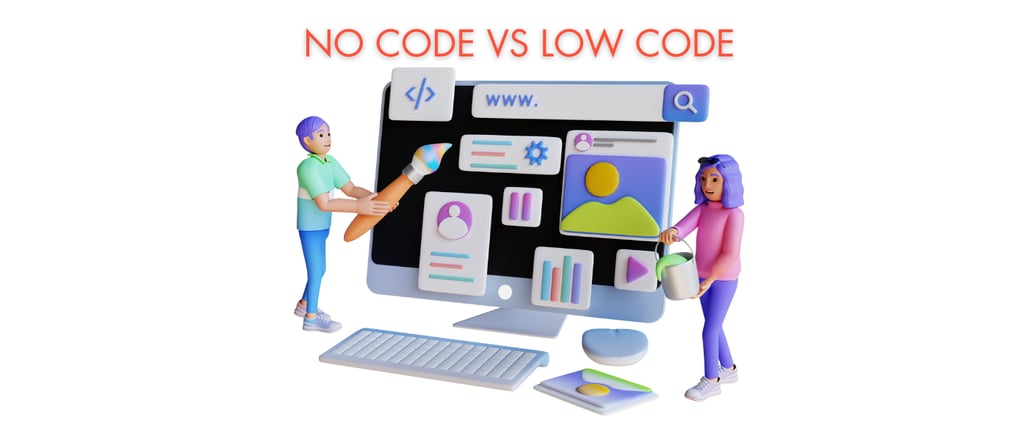No-Code vs Low-Code: Which One Is Right for Your Business?
In today’s digital landscape, businesses need to innovate faster than ever. Traditional software development can be slow and expensive, leading many organizations to explore no-code and low-code development platforms. But which one is the right fit for your business? Both approaches offer rapid application development, but they cater to different needs. No-code platforms enable non-technical users to build applications using a visual interface, while low-code platforms provide more flexibility for developers who need to customize solutions. In this blog, we’ll compare no-code vs low-code, explore their advantages, and help you determine which approach aligns best with your business needs.
CREATIO
3/31/20252 min read


1. What is No-Code Development?
No-code development allows users to build applications without writing a single line of code. These platforms provide a drag-and-drop interface that lets business users create apps quickly without relying on IT teams.
Key Features of No-Code Platforms:
Visual Development: Design workflows using a graphical interface.
Pre-Built Templates: Ready-to-use solutions for common business needs.
Automation Capabilities: Automate repetitive tasks like approvals, notifications, and customer interactions.
Integration with Business Tools: Connect with third-party applications like CRMs and ERPs.
Who Should Use No-Code?
Small businesses looking for simple app solutions.
Non-technical users who need automation tools.
Companies that want quick, cost-effective app development.
Example Use Case: Small Business Automation
A retail business used a no-code workflow automation tool to streamline order processing and customer notifications. Within two weeks, they had a fully functional order management system without hiring a developer.
💡 Want to explore no-code platforms? Learn more about our no-code solutions!
2. What is Low-Code Development?
Low-code development provides a balance between visual development and custom coding. While it includes drag-and-drop elements, it also allows developers to write code where needed, making it suitable for more complex applications.
Key Features of Low-Code Platforms:
Customizable Components: Developers can modify code to fit specific business needs.
Integration with Legacy Systems: Easily connects with existing databases and software.
Advanced Workflow Automation: Handles complex business logic and multi-step processes.
Scalability: Suitable for enterprise applications that need long-term support.
Who Should Use Low-Code?
Medium to large enterprises needing scalable solutions.
IT teams that want to accelerate software delivery.
Businesses with unique processes that require customization.
Example Use Case: CRM Customization for a Growing Business
A mid-sized finance company used Creatio’s low-code platform to build a custom CRM solution that integrated with their accounting software. By combining visual development with coding, they created an advanced workflow that handled lead tracking, invoicing, and customer communication.
💡 Need a customized solution? Hire Creatio developers today!
3. No-Code vs Low-Code: A Feature Comparison
Feature: No-Code/Low-Code
Coding Required? Some coding required
Development Speed: Fastest
Customization: High
Use Cases: Complex apps & automation & integrations
Best for: Business users & IT teams & developers
Which One Should You Choose?
If you need quick and simple automation, go for no-code.
If your business needs scalability and customization, choose low-code.
If you’re unsure, consider hybrid approaches that combine both technologies.
4. The Best No-Code & Low-Code Platforms in 2025
Top No-Code Platforms:
Creatio Studio Free - Best for business process automation.
Bubble - Great for building web applications.
Zapier - Best for automating workflows between apps.
Top Low-Code Platforms:
Creatio - Best for CRM and enterprise automation.
OutSystems - Great for large-scale app development.
Mendix - Ideal for rapid app development in enterprises.
💡 Explore the best no-code/low-code platforms for your business!
5. How AavishkarIT Can Help
At AavishkarIT, we specialize in low-code and no-code development to help businesses automate workflows, build scalable apps, and reduce IT costs. Our team of Creatio experts can help you:
Implement low-code CRM automation.
Develop no-code business process solutions.
Integrate AI-powered automation for better efficiency.
🚀 Ready to build your next app? Book a Free Demo today!
AavishkarIT Solutions
Innovate Faster, Automate Smarter
Contact
info@aavishkarit.com
+918368785127
© 2025. All rights reserved.
Industries
Cloud and Devops Services
Custome CRM developemnt
By submitting this form, you confirm that you agree to the storing and processing of your personal data by AavishkarIT as described in the Privacy Policy.
Services
Low Code / No Code
Education
HyperAutomation Services
Financial Services
Healthcare
Travel
IT & Software Services
Consulting & others
